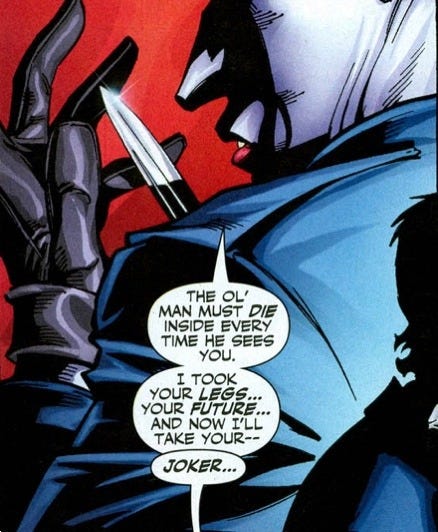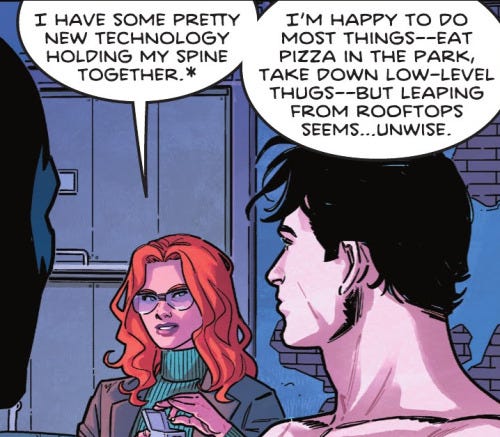batgirl: a tell-all of misogyny & ableism in comics
although this article briefly goes over batgirl’s origins as a role, the rest of the focus will be on specifically the iteration with barbara gordon.
Though few outside of the comic-sphere know of the intricacies of DC’s Batgirl mantle, the rampant bigotry within the community has always been prevalent, under the radar or not. Batgirl has repeatedly been used as a narrative device for other characters’ development, as well as having her own taken away from her.
The role of Batgirl started as a pushback against the narrative that Fredric Wertham published in his 1954 novel Seduction of the Innocent. In it, he states that comics are causing children to become more sexual, even equating homosexuality to be something predatory. Wertham cites Batman and Robin’s relationship to be:
The [...] type of story [that] may stimulate children to homosexual fantasies, of the nature of which they may be unconscious. 1
And that:
Only someone ignorant of the fundamentals of psychiatry and of the psychopathology of sex can fail to realize a subtle atmosphere of homoerotism which pervades the adventures of the mature “Batman” and his young friend “Robin.” 2
DC created Batgirl (and Batwoman) so that Batman and Robin would have a female figure to regularly interact with, in order to “throw off” the accusations. The very origin of the role only existed for the sake of men, and for DC to gain a better reputation.
Batgirl was later reprised for the Batman (1966) show. Artist and editor Carmine Infantino states,
The “Batman” TV producer called Julie and said Catwoman was a hit, could we come up with more female characters? Julie called me and asked me to do that. I came up with Batgirl, Poison Ivy and one I called the Grey Fox, which Julie didn’t like as much. Bob Kane had had a Bat-Girl for about three stories in the ’50s but she had nothing to do with a bat. She was like a pesky girl version of Robin. I knew we could do a lot better, so Julie and I came up with the real Batgirl, who was so popular she almost got her own TV show. 3 4
Later, Batgirl became an identity independent from the dynamic duo, or any other male superhero for that matter.
The storyline that makes Barbara Gordon’s Batgirl into Oracle is troubling, a prime example of her pain being made a commodity (we’ll touch on that soon), despite this, or perhaps because of it her role as Oracle becomes representative of healing, coming to be her own.
The Killing Joke, a 1988 one-shot novel penned by Alan Moore, features Joker torturing police commissioner Jim Gordon… through his daughter. Showing up at Barbara Gordon’s door, Joker proceeds to shoot her, causing her to go into paralysis. He then strips her and takes photos of her nude to show her father.
Elise Ringo sums up Barbara’s commodification perfectly in their article on TKJ:
This assault is exploited less for the potential it offers Barbara (as a long-time, well-established figure in DC) than for the emotional impact it has on her father – making it a classic “fridging” of a female character. Furthermore, recent revelations of the original art for the pages (NSFW) show that the version published was actually toned down – as originally drawn, it makes the sexual aspects of the attack on Barbara more explicit. 5
DC has a history of “fridging” female characters, a term used when a character is hastily cast aside, put through immense pain, etc, all for the advancement of another (typically male) character’s storyline and development. In fact, they're so prolific for their fridging that they originated the term. Quite literally by having Green Lantern Kyle Rayner’s girlfriend murdered and shoved in a fridge. 6
And, to paraphrase Rayne Fisher-Quann in her article on the treatment of Amber Heard: no matter how much men despise a woman, they will always, always have a desire to see her nude, treated as a sexual object. 7 I’m not trying to accuse any writers, execs, or even readers of “hating” Babs. However, I am saying that only through implicit bias towards female characters could this have happened in the first place. 8 Even in the film adaptation of TKJ, there’s a heavy, heavy implication that Batgirl and Batman have (frankly unnecessary & unethical) sex.
TKJ was never about her.
I know I’ve made my point, but Babs’ pain being used for others won’t ever sit right with me. Especially when juxtaposed with, say, how Jason Todd’s character arc, mainly in A Death In The Family & Under The Red Hood, was treated.
Jason’s death by Joker was yes, for Batman’s story, but
Jason was literally dead– or at least assumed to be, there was little development before it was revealed he was alive that Jason could have gotten.
Jason wasn’t dead actually! His “death” did actually lead to being fully fleshed out in 2005. UTRH is as much about Bruce as it is about Jason.
Post TKJ, Babs is now in a wheelchair, thriving, if I’m honest. As Oracle, she uses her technological skills to help others 9 through organization, in-time comms, as well as being one of the main sources of current intel. She’s stopped fearing Joker, even talking back to him 10:
If she’s constantly reverted back to Batgirl, a major part of her character and growth is stripped away, often for arbitrary reasons. Even now, in the current Nightwing run penned by Tom Taylor, Barbara has not necessarily been cast aside, rather, left as a romantic plot device for the eponymous Nightwing.
In a recent issue of the fourth volume, Taylor takes away Barbara’s wheelchair and replaces it with an artificial spine. Even insinuating that while in a wheelchair she couldn’t take down “low-level thugs” and I am not kidding– “eat pizza in the park.” 11
In doing so, Taylor has caused Barbara’s character to regress. It’s back at the stage where she’s no longer a person. Just barely a flag that Taylor can wave to say that he has “successfully” written a female character. I have further opinions on the happenings of this run but I will save you from all of them except for the fact that the pacing is atrocious, things are happening but things aren’t happening iykwim. While Taylor isn’t responsible for the previous actions of other writers, what he is choosing to write now is showing that he’s just giving (and will most likely continue to give) empty acknowledgement of Barbara’s life as a disabled woman, not doing anything beyond it.
By never acknowledging the past, how can you possibly change the future?
Fredric Wertham, “Seduction of the Innocent”, Rinehart & Company, April 19 1954, p. 207
Fredric Wertham, “Seduction of the Innocent”, Rinehart & Company, April 19 1954, p. 205
Around here does Barbara Gordon’s Batgirl really come into fruition, before, (in Bob Kane’s version that’s mentioned) it’s Betty Kane
Desperately wanted to include how Alan Moore was told by editor Len Wein to “cripple the bitch” when asked if anyone had a problem with his plan for TKJ. Alas, my half-assed journalistic integrity won’t allow me to include it as I couldn’t find a solid, original link for this even with the knowledge that it was from a 2006 Wizard Magazine. However, it’s mentioned in a ton of other sources like the previously mentioned article by Elise Ringo, as well as a Guardian article, in an article within the archive for “Lonely Gods: Minorities In American Superhero Comic Books”… I don’t believe there has been a contradiction to the statement either. Whichever way, I will contradict my own statement and say that Wein’s misogyny in this quote is not even implicit, if anything it’s beyond blatant.
“others” being anyone from the Batfamily, the Birds of Prey, the Suicide Squad, the Justice League… girl is a powerhouse









i love you marry me please